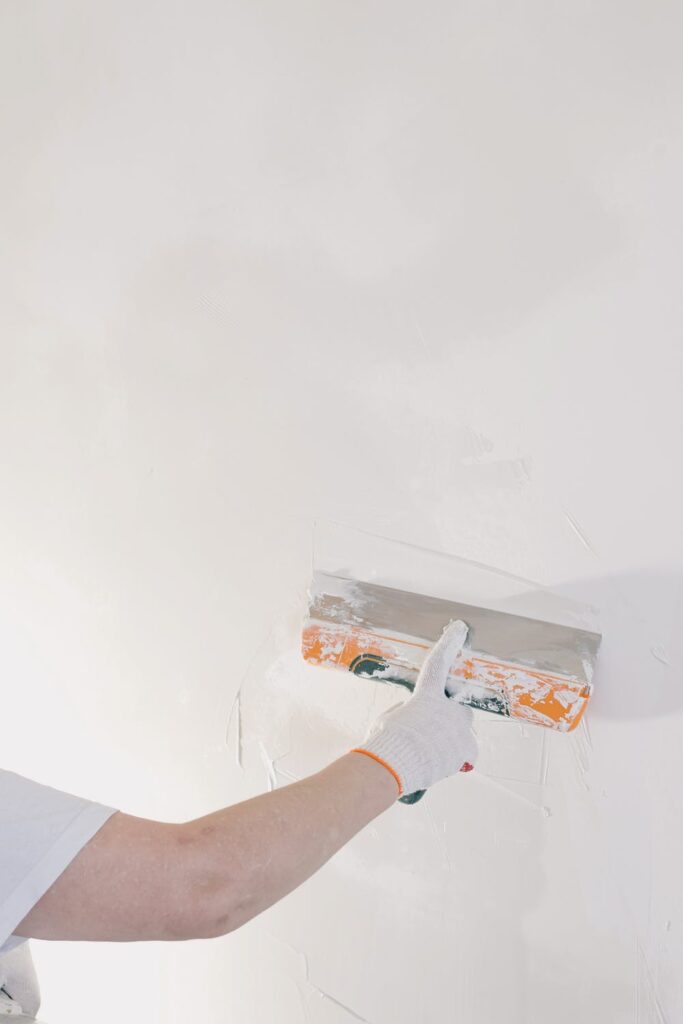Fascination About Plasterer
Wiki Article
Plasterer Can Be Fun For Everyone
Table of ContentsNot known Details About Plasterer Plasterer - An Overview10 Easy Facts About Plasterer ShownThe 8-Second Trick For PlastererAn Unbiased View of PlastererSome Known Factual Statements About Plasterer Plasterer Can Be Fun For AnyoneThe 7-Minute Rule for PlastererThe Greatest Guide To PlastererThe Greatest Guide To Plasterer
In the United States the names utilized for plastering or plasterboard are Drywall, Wall Board or Sheetrock. In Australia we frequently refer to plasterboard as Gyprock as well as this is a brand name that was started in in 1947 by CSR.Today, plasterboard is still made by sandwiching a layer of gypsum plaster between 2 thick sheets of paper.For the art background of three-dimensional plaster, see stucco. The earliest plasters understood to us were lime-based. Around 7500 BC, the individuals of 'Ain Ghazal in Jordan utilized lime combined with unheated smashed sedimentary rock to make plaster which was made use of widespread for covering walls, floorings, as well as fireplaces in their houses.
In old India and China, provides in clay and plaster plasters were utilized to generate a smooth surface over rough rock or mud block walls, while in early Egyptian burial places, walls were coated with lime as well as gypsum plaster and also the completed surface area was commonly repainted or embellished. Designed stucco was used throughout the Roman Empire.
5 Simple Techniques For Plasterer
Oil mastics introduced in the UK in this duration consisted of a "Composition or stone paste" patented in 1765 by David Wark. This was a lime-based mix and included "oyls of tar, turpentine as well as linseed" besides many other active ingredients. One more "Structure or cement", including drying oil, was patented in 1773 by Rev.This was translated into English as "A Practical Essay on a Cement, and also Artificial Rock, justly intended to be that of the Greeks and Romans" and also was published in the very same year. Following this, and as a backlash to the dissatisfaction really felt due to the repeated failing of oil mastics, in the second fifty percent of the 18th century water-based renders gained appeal again.
By the mid 19th century manufacturing centres were preparing cast rocks based on cement for usage in buildings. These were made mainly with a cement mix typically integrating fine and also coarse accumulations for structure, pigments or dyes to mimic colouring as well as veining of all-natural rocks, along with various other additives.
The Greatest Guide To Plasterer
Laths were formerly all made by hand. Most are currently made by machinery and are referred to as sawn laths, those made by hand being called rental fee or riven laths. Rent laths offer the very best results, as they split straight with the grain of the wood, and also are more powerful and not so accountable to twist as industrial laths, several of the fibers of which are normally reduced in the procedure of sawing.By breaking the joints of the lathing in this method, the propensity for the plaster to break along the line of joints is decreased and a better trick is gotten. Every lath must be nailed at each end and any place it goes across a joist or stud. All woods over 3 inches (76 mm) wide should be counter-lathed, that is, have a fillet or dual lath nailed along the centre upon which the laths are then nailed.
Walls responsible to damp are sometimes battened and lathed to create an air tooth cavity in between the wet wall as well as the plastering. Lathing in steel, either in wire or in the type of perforated galvanised sheets, is currently extensively utilized therefore its fire resistant as well as long-term quality. There are many kinds of this material in different designs, the best recognized in England being the Jhilmil, the Bostwick, Lathing, as well as Expanded Steel lathing.
Some Known Details About Plasterer
Lathing nails are generally of iron, cut, functioned or cast, and also in the far better class of work they are galvanized to avoid rusting. Zinc nails are in some cases used, but are costly. Lime plastering is made up of lime, sand, hair and also water symmetrical differing according to the nature of the job to be done.Hydraulic limes are additionally utilized by the plasterer, but mainly for exterior job. Perfect slaking of the calcined lime prior to being utilized is very vital as, if used in a partially slaked condition, it will certainly "blow" when in setting as well as sore the job. Lime ought to therefore be run as quickly as the structure is begun, as well as at the very least three weeks need to elapse in between the procedure of running the lime as well as its use.
Great hair needs to be long (In the UK cow as well as steed hair of short as well as lengthy sizes is made use of), and also left greasey (lanolin grease) since this secures against some deterioration when presented into the really high alkaline plaster. Before usage it have to be well defeated, or teased, to divide the lumps.
The Greatest Guide To Plasterer
The quantity used in great is one pound of hair to two or three cubic feet of coarse stuff (in the UK approximately 12 kg per statistics cube). Hair reinforcement in lime plaster prevails and numerous sorts of hair and various other natural fibers can be discovered in historic plasters (Plasterer).For external job Rose city concrete is the very best product therefore its strength, toughness, as well as weather condition standing up to outside properties, yet out historical frameworks that are required to bend as well as take a breath; for this, lime without cement is made use of. Sawdust has actually been used as a substitute for hair as well as also rather than sand as an aggregate. Stucco is a term freely put on nearly all type of external plastering, whether made up of lime or of cement. At today time it has fallen under disfavor, yet in the early component of the 19th century a lot of this work was done. Cement has mostly obsolete lime for this work.
Shovelled stucco, the ending up layer of this work, is composed of three parts sand to two components fine things. It is laid on in 2 layers with a skimming float, scoured off at when, as well as then shovelled.
The smart Trick of Plasterer That Nobody is Discussing
The second layer is also made up of rugged stuff knocked up to a smooth and consistent consistency.
A very first coat or making of Rose city cement and sand, in the percentage of one to three, is laid on about an inch thick; after that adheres to the shade coat, sometimes placed on in spots of different tints as needed for the finished design. When this layer is virtually completely dry, it is completed with a smooth-skimming, 112 to 18 inch (2.
, and lath as well as lay or lath as well as plaster one coat on studding. Two-coat job is usually made use of for factories or warehouses as well as the much less vital rooms of houses.
Our Plasterer Statements

The procedure for three layer work is as follows: For the initial coat a layer of well-haired rugged things, about 1 inch thick, is put on with the laying trowel. This is described "pricking up" in London, and also in America "scrape covering". It must be laid on diagonally, each trowelful overlapping the previous one.

Some Known Factual Statements About Plasterer
The searching of the drifting coat is of fantastic relevance, for it settles the material, as well as, besides setting it, prevents it from fracturing. It is done by the plasterer with a hand float that their explanation he uses vigorously with a fast round motion, at the same time sprinkling the collaborate with water from a stock brush in the other hand.The entire surface area needs to be uniformly scoured two or 3 times, with an interval between each procedure of from 6 to twenty-four hrs. This process leaves the plaster with a close-grained and fairly smooth surface, using little or no trick to the layer that is to comply with. To get proper cohesion, nevertheless, a roughened face is required, and also this is obtained by keying the surface area with a cord brush or nail float, that is, a hand float with the factor read this article of a nail sticking via as well as predicting around 1/8 inch; sometimes a point is placed at each corner of the float.
The third and final coat is the setup layer, which must have to do with 1/8 inch thick. Plasterer. In Scotland it is labelled the "finishing layer", and in America the "hard finish layer" or "putty layer". Setting things must not be applied till the floating is quite firm and nearly completely dry, yet it must not be also completely dry or the moisture will certainly be attracted from the setting stuff.
Fascination About Plasterer
It should be blended with tidy water to such a consistency that a quantity noticed the point of a trowel holds well with each other and also does not go down. Drifting things is of finer texture than that utilized for puncturing up, and also is used in a softer state, allowing it to be worked well into the keying of the first coat.Fine things blended with sand is used for the setup layer. Great things, or lime putty, is pure lime that has actually been slaked and afterwards mixed with water to a semi-fluid uniformity, as well as enabled to stand up until it has turned into a soft paste. For use in setting it is mixed with fine washed sand in the proportion of one to 3.
This is typically gauged stuff, composed of 3 or 4 components of lime putty and one component of plaster of Paris, blended up in tiny quantities promptly prior to usage. The plaster in the product causes it to establish quickly, however if it exists in as well large a percentage the work will certainly break in setup.
The Basic Principles Of Plasterer
In 2 layer provide a skim coat is used with an usual mix of 4 components sand to one part cement as well as one component dried lime and also water to make try this website a regular mortar. Provide is used making use of a hawk as well as trowel as well as pressed on regarding 12 mm thick to begin.
Report this wiki page